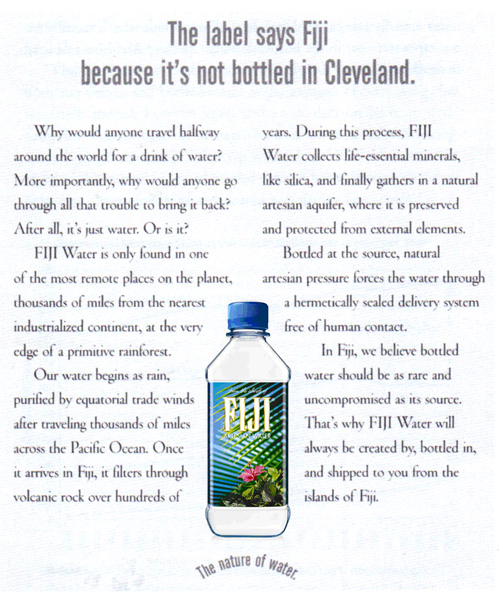Water World

Bottled water is ubiquitous in the United States. According to the International Bottled Water Association (IBWA, and yes, the IBWA is a real group), Americans drank 11 billion gallons of bottled water in 2014, an amount with a wholesale value of $13 billion. But, that said, as IBWA points out, that’s a drop in the bucket: “U.S. public water systems supply more than 1 billion gallons of tap water an hour, every hour of the day. The total amount of bottled water Americans buy in one year would only supply U.S. tap water needs from midnight until 9 a.m. on January 1.”
But that doesn’t stop bottled water brands from trying to take some of that market share. And to make that case, bottled water brands have to make the claim that their product is superior to the stuff that comes out of the tap. Take, for example, the magazine ad below from a decade ago, promoting Fiji-brand bottled water.

“The label says Fiji because it’s not bottled in Cleveland,” the ad states boldly. If one were price-sensitive, the that’d be a bad claim to make — Fiji-brand water is much, much more expensive than the stuff that comes out of the tap in the Cleveland area. To compare some prices, a 12-pack of 1.5-liter bottles of Fiji sells for $32 on Amazon. That’s pretty expensive: in total, that 12-pack has 18 liters or about 4.75 gallons of water, and it costs about $6.75 a gallon — more than three the cost of a gallon of gas as of this writing ($2.211). On the other hand, an “MCF” (1,000 cubic feet) of municipal water in Cleveland runs about $11.55, and as there are 7,480 gallons in an MCF, that comes to about $0.0015 per gallon. The price of those 18 gallons of Fiji water, had they been bottled in Cleveland? About $0.03 — for the entire 12-pack. (The bottles, empty, are probably more expensive than the water.)
So Fiji isn’t competing on price, that’s for sure.
Quality, on the other hand? That’s where Fiji’s makes its case. Their water, per their ad, comes from “one of the most remote places on the planet, thousands of miles from the nearest industrialized continent, on the edge of a primitive rainforest.” You know — untouched, shielded from all the bad stuff humans do, and therefore, pure. And just to show how pristine the water is, the ad continues by informing the reader that Fiji-brand water is “purified by equatorial trade winds” and “filters through volcanic rock over hundreds of years.” It’s as good as water gets!, they claim. And it’s certainly not from, eww, Cleveland.
An effective ad? Maybe — unless you’re in charge of Cleveland’s water supply.
Most people wouldn’t care about the not-so-subtle jab at Cleveland’s water, but the Cleveland Division of Water took it personally. So, they fought back, with science. The Division of Water tested Fiji-brand water as well as a few of its competitors’ products, and, of course, Cleveland’s very own tap water. The results weren’t very good for Fiji. The Washington Post reported that the city found “6.31 micrograms of arsenic per liter in the Fiji bottle,” while “Cleveland tap water as well as bottled brands Aquafina, Dasani and Evian had no measurable arsenic.”
Fiji didn’t take too kindly to the test, telling the city to lighten up — it was only a joke. The company also did its own test and found that Fiji-brand water never had more than two micrograms of arsenic per liter, although that’s still more than zero. Don’t worry about it, though — the Environmental Protection Agency advises that drinking water can have up to 10 micrograms per liter of arsenic before it’s a problem. But if you want to drink Cleveland tap water instead, no one will blame you.
Bonus fact: Americans drink a lot of bottled water, but according to the IBWA, the U.S. is only eighth (as of 2013) in gallons of bottled water drank per capita. Per this pdf (page 19, specifically), American drink 32.0 gallons per capita annually, slightly more than Spain (31.9) and Hong Kong (31.2), and a bit less than France (36.5) and the United Arab Emirates (37.3 gallons). But that’s nothing compared to Mexico, who tops the list with 67.3 gallons of bottled water quaffed per person, per year.
From the Archives: Nine-Tenths of a Cent: Above, you’ll note that the average price of gas is $2.211 — which is one decimal place more than we’re used to. That’s typical for gas prices; this is the history behind why.
Take the Quiz: Can you name the U.S. states by their bodies of water? This was surprisingly hard and yet I managed to do passably well.
Related: 18 liters of Fiji-brand bottled water. Your tap water is probably fine, though.
